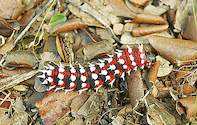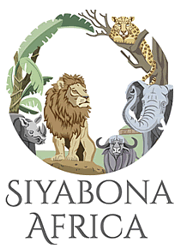
About Southern Mopaneveld
Engelhard Dam
Letaba Area
Letaba Camp to Mozambique
Letaba to Mopani
Letaba to Olifants
Olifants Area
Palaborwa Gate Area
Phalaborwa to Letaba
Phalaborwa to Mopani
See Kruger Park Olifants Area Self-drive Map
Phalaborwa to Mopani Camp (H14)
The Mopani-Phalaborwa Road (H14) passes Shikumbu Mountain (494m), which was occupied by the same 19th-century iron-making communities that inhabited Masorini. These hills served as landmarks of human habitation for anyone crossing the hot lowveld plains. Shikumbu is still regarded by many as a sacred hill associated with powerful muthi. Traditionalists in the area say that to point a finger at the granite mountain is to invoke bad luck.The H14 tracks the seasonal Ngwenyeni stream ("place of the crocodile") and follows the riverine bush through the flat mopane bushwillow woodlands. There is usually animal activity around Nandzane Water Hole, which marks the confluence of the Ngwenyeni and Shicindzwaneni ("place of the ilala palms") watercourses. Nandzane is the Shangaan name for the caracal or rooikat, a medium-sized hunting cat with distinctive long and fluffy ears.Mopaneveld - Landscape of the North

Mopane (Colophospermum mopane) is the most common tree in Kruger. Mopaneveld, which is the environment dominated by mopane trees or shrubs, covers more than half the Park's total surface and dominates the central and northern areas. Mopane is a deciduous tree that varies in size in different localities - a major influence being climate, soil condition and elephant activity.
The mopane tree is recognisable by its roughly grooved bark and, during winter and spring, by its roundish leaves which become golden-brown. Being rich in phosphate and calcium, it is an essential part of the diet of the biggest animal in Kruger - the elephant - and one of the smallest - the mopane worm (Imbrasia belina).
During summer, aphids leave a sugar residue on mopane leaves and this is particularly relished by elephants. Mopane wood is sometimes used in furniture making because it is termite resistant.
There are three main types of mopaneveld in Kruger
- Mopane woodlands found on granite in the north-west of the Park - mixed in with acacia and bushwillows;
- Mopane shrubveld found on basalt in the north-east of the Park;
- Mopane thickets found on shales in the far north of the Park.
There are some beautiful loop roads off the H14 along the stream bank. This is a recommended winter drive as there is usually a concentration of game in the bush along the watercourse where pools of water remain late into the dry season. The Letaba River is one of the great bushveld arteries and it is worth stopping at the high-level bridge to study the surrounding area.
There are often buffalo, giraffe, elephant, wildebeest, kudu and other antelope along the banks of the Letaba and the birding is usually good. In the north most animals are found in close proximity to the major rivers, particularly in winter when the pans dry up and the rain clouds disappear.
After crossing the broad and sandy bed of the Letaba River, the H14 Road continues towards the main Letaba-Mopani Road (H1-6) with turn-offs to Shimuwini Bushveld Camp and Boulders Bush Lodge. Game viewing along the H14 north of the Letaba River is not particularly good until one passes the trio of granite outcrops of Tsale (450m), Kaleka (396m) and Ngodzi (472m), which signal the start of the sweeter grass of mopane shrubveld on basalt.
Masorini Iron-Age Site

Masorini is an Iron-Age archaeological site occupied during the 19th century by the Majola, a sub-group of the Sotho-speaking baPhalaborwa people. The Majola were iron smelters and forgers and probably traded metal, food and ivory products with other communities across the lowveld and as far as the Mozambican coast.
The village has been partially restored and one can see the furnaces where smelting took place. The art of smelting was considered sacred and reserved only for men. If a pregnant woman was seen near a furnace it was deemed a particularly bad omen.

From the artifacts and food remains excavated at Masorini, it appears that the residents grew and processed sorghum and supplemented their diet by hunting. No domestic animal remains have been found.
Archaeologists believe the Majola were the last in a long line of people who occupied the site, which has evidence of human habitation going back more than 1000 years.
Better Than the South
Phalaborwa was settled by Sotho-speaking iron-working communities in the 16th century. The name literally means "Better than the south" because of the rich mineral profile of the area. Between 1800 and 1850, the baPhalaborwa were at the peak of their power under the chief Malatji, controlling a vast swathe of land between the Oliants and Letaba Rivers.
Their influence waned as the ivory trade was wrested from their hands by João Albasini in the 1860s, and then, again, with the influx of European agricultural implements in the 1880s, which affected the viability of their smelting and forging businesses.

Shilawuri Hill (414m), is a great gabbro boulder which has been a lowveld navigational landmark for centuries. It marks the watershed between the usually dry N'washidzundzu and Nhlanganini watercourses. There is a loop road to Nhlanganini Water Hole which, when there is water, is inhabited by hippo. Elephant and buffalo are often seen along the Nhlanganini creek, which is on the edge of a strip of sandveld.
The diversity of vegetation here stands out noticeably from the mixed mopane bushwillow woodlands to the west and the shrub mopane to the east. Because of the variety of edible plants around, there is usually game to be seen. Look out for the pan-hinged terrapin at Nhlanganini.
There are sometimes scores of these turtle-like creatures at this water hole. They are common throughout the Park, evading predators because of their ability to release a powerful odour that makes them smell like lions.

 A green and thriving oasis, Letaba Rest Camp offers comfortable accommodation in Kruger Park with excellent Elephant and bird viewing opport...
A green and thriving oasis, Letaba Rest Camp offers comfortable accommodation in Kruger Park with excellent Elephant and bird viewing opport... Mopani Rest Camp is the newest of all the Kruger Park rest camps and commands a spectacular view over the Pioneer Dam. Mopani Rest Camp Faci...
Mopani Rest Camp is the newest of all the Kruger Park rest camps and commands a spectacular view over the Pioneer Dam. Mopani Rest Camp Faci...